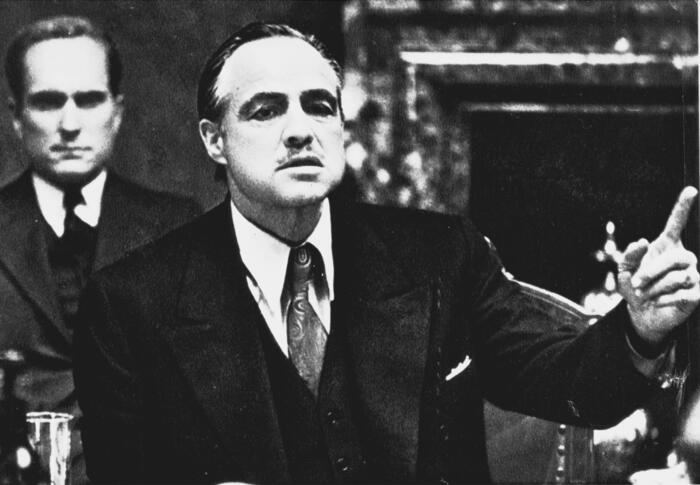One hundred years ago, on April 3, 1924 in Omaha, Nebraska, the third child of pesticide and chemical manufacturer Marlon Brando Senior was born. The child had the same name as his father whom he hated throughout his childhood; to stand out from him he called himself Bud, until he became famous with the name of Marlon Brando, thus erasing his father's memory. The son, on the other hand, considered his mother Dorothy her muse and greatest love, so much so that he admitted that he only acted to gain the consideration of "his" and Dorothy of hers.
German, but also English, French and Dutch blood flowed in the veins of the Brandau family (this is the original surname of a certain Johan Wilhelm who arrived in America in search of fortune in the 18th century). The future star therefore had within himself all the chromosomes of the young nation and the determination of the pioneers. Raised between California, Illinois and Minnesota (where he was kicked out of the military academy), Brando arrived in New York in 1943 and enrolled in Stella Adler's acting courses in Erwin Piscator's Dramatic Workshop, where he was struck by the Method. Stanislavskij, then refined at Lee Strasberg's Actors Studio. Just a year later, Marlon made his Broadway debut in the comedy "I Remember Mama" and, after the war had just ended, he confirmed himself in Ben Hecht's "A Flag is Born". He already had very clear ideas in politics too (to support the nascent state of Israel he committed to working at minimum wage) and he loved the theatre, as confirmed by his personal success in "A Streetcar Named Desire" by Tennessee Williams. The move to the cinema was short and in 1951 Elia Kazan wanted him for the Hollywood version of the comedy. Athletic physique, magnetic gaze, testosterone pumping, Brando became a star. After all, he had already demonstrated his maniacal versatility in Fred Zinnemann's "My Body Belongs to You" playing a paraplegic veteran suffering from serious depressive disorders.
Then the myth of the "Actors Studio" actor was born, which places all the emphasis on the physical credibility of the character and on the obsessive adherence to the psychological dimension of the same. Thanks to the "Brando style" an entire generation of actors was successful, from Paul Newman to Gene Hackman. Roles that became iconic in his career followed from "Viva Zapata" to "Giulio Cesare" (in which he towers over the part of Marc'Antonio) to "The Savage" (leather jacket and motorcycle on display). In 1954 he already had three Oscar nominations behind him, a goal he achieved in '56 with "On the Waterfront" alongside Rod Steiger. Again directed by Kazan, he plays the longshoreman and former boxer Terry Malloy, forced by his brother to fix a match. Returning to the theater for the last time with "Arms and the Man" by GB Shaw, he definitively embraced Hollywood, becoming its undisputed and quarrelsome protagonist, a powerful ruler of American cinema in the 50s and 60s. Upon closer inspection, despite the ostentatious perfectionism and constant success, the subsequent films are not among the most beautiful in the history of cinema: in "Desirée" Brando built an unlikely Napoleon in his own image and likeness, in "Bullies and Dolls" he tried without great conviction in singing and dancing, in "Sayonara" (10 nominations) and in "The Young Lions" he was only professional, in "Snake Skin" he worked above all on neurosis and depression. Yet he was now an undisputed model and a guarantee of success, confirmed in 1962 by the triumph of "Mutiny on the Bounty" despite criticism that was not all kind. On that set he met the married Tahitian Tarita Teriipia shortly thereafter.
His civil commitment alongside workers in the March on Washington in 1963, his irascible and temperamental character, the rumors about his bisexuality (as in the case of his tormented relationship with James Dean who idolized him) saw him less and less loved by the studios. Nor did a series of failures such as his only directorship (the western "The Two Faces of Vengeance" brutally massacred by the production) or the beautiful "The Hunt" by Arthur Penn, contested for its indictment against the racism. After the sensational failure of "The Countess from Hong Kong" directed by Charlie Chaplin in 1967, his decline appeared unstoppable. Emboldened, depressed, holed up in his retreat in Tahiti, Marlon Brando seemed finished forever. Italian cinema came to his rescue with "Queimada" by Gillo Pontecorvo (now rediscovered as a cult work) and "Last Tango in Paris" by Bernardo Bertolucci, which Brando also accused of manipulation until a laborious reconciliation in the 1990s. It was precisely the charisma built in him by European cinema that convinced Francis Ford Coppola to fight against Paramount to have him in the part of Don Vito Corleone in "The Godfather". The result was the Oscar for best actor in 1973. His appearance on stage, against the light, hoarse voice and drooping cheeks (obtained with cotton wool in his mouth), a simple gesture of the hand and controlled mobility of the gaze remain an unsurpassed interpretative lesson.
Yet "The Godfather" seemed to be his swan song: all that followed were appearances of pure "food" interest, private pain (the suicide of his daughter Cheyenne) and public anger (the failure to attend the Oscar ceremony in solidarity with the Natives Americans), until his spectacular resurrection as Colonel Kurtz in "Apocalypse Now", again with Coppola directing. Then, in a self-destructive vortex, Marlon Brando dragged himself until his death from pulmonary emphysema on July 1, 2004. Despite many loves (four official companions, 11 children, countless female and male lovers), dizzying rises to glory and sensational crashes, nothing Even today it undermines his icon of physical power, technical prowess and bursting artistic personality. For this reason he is perhaps the only star of old Hollywood whose posters still stand out in teenagers' bedrooms and the myth of him survives him.
Reproduction reserved © Copyright ANSA

